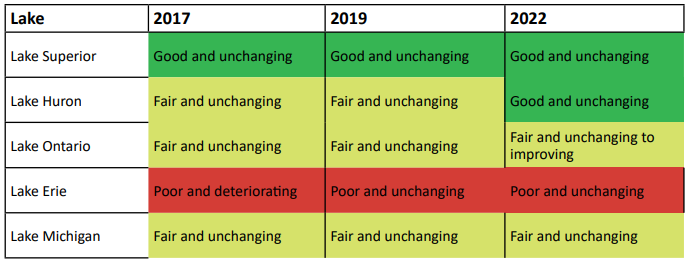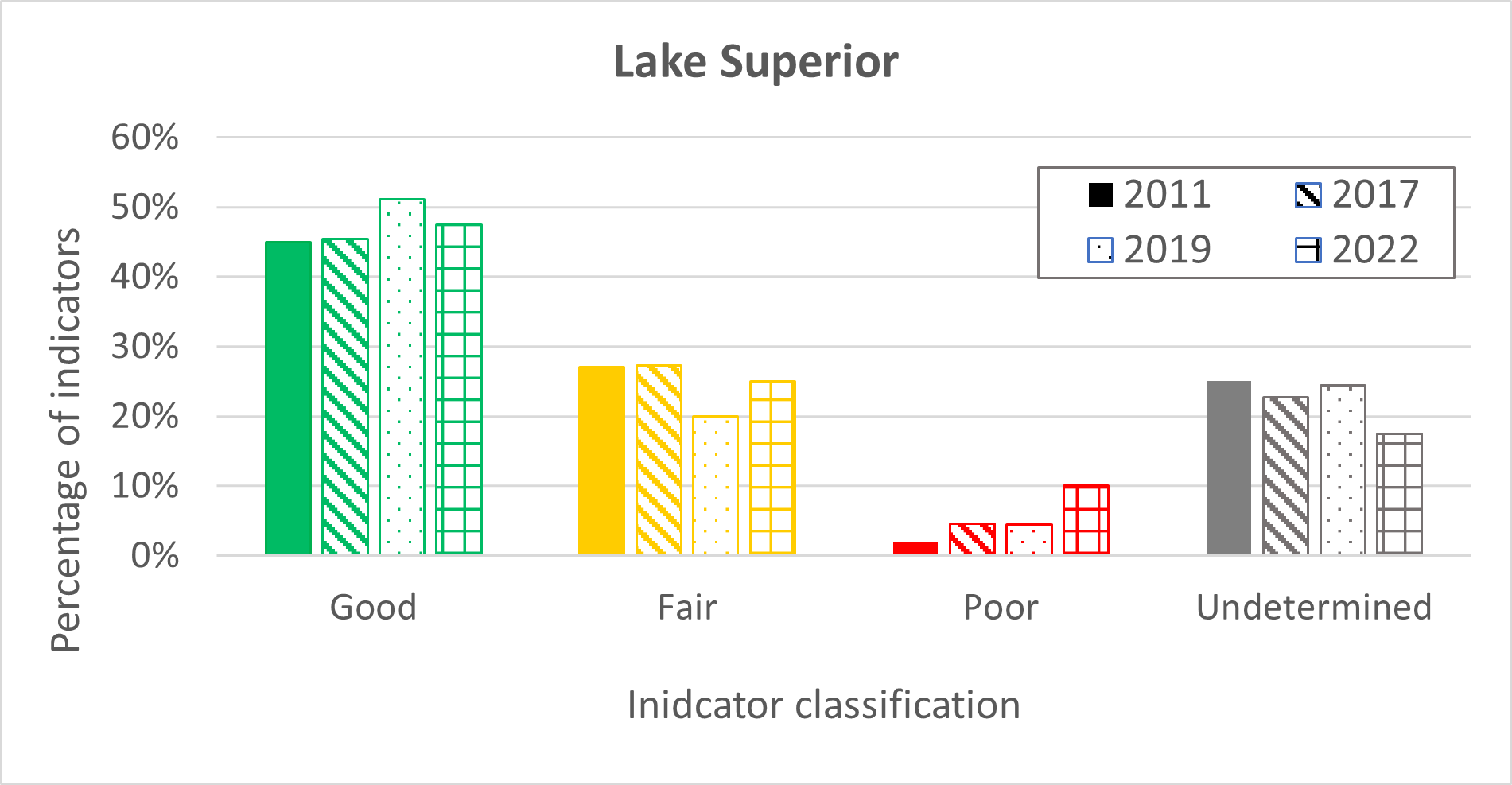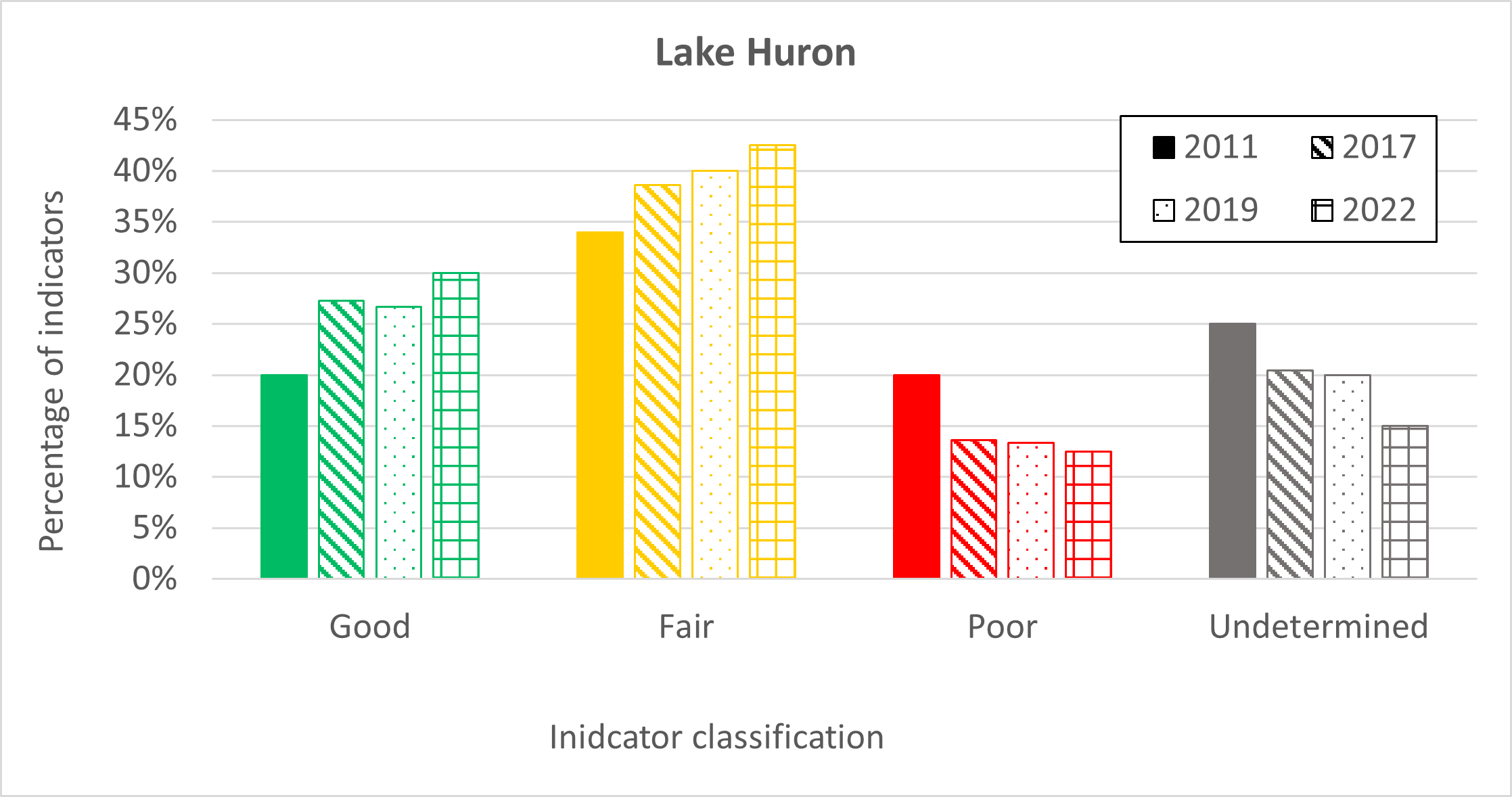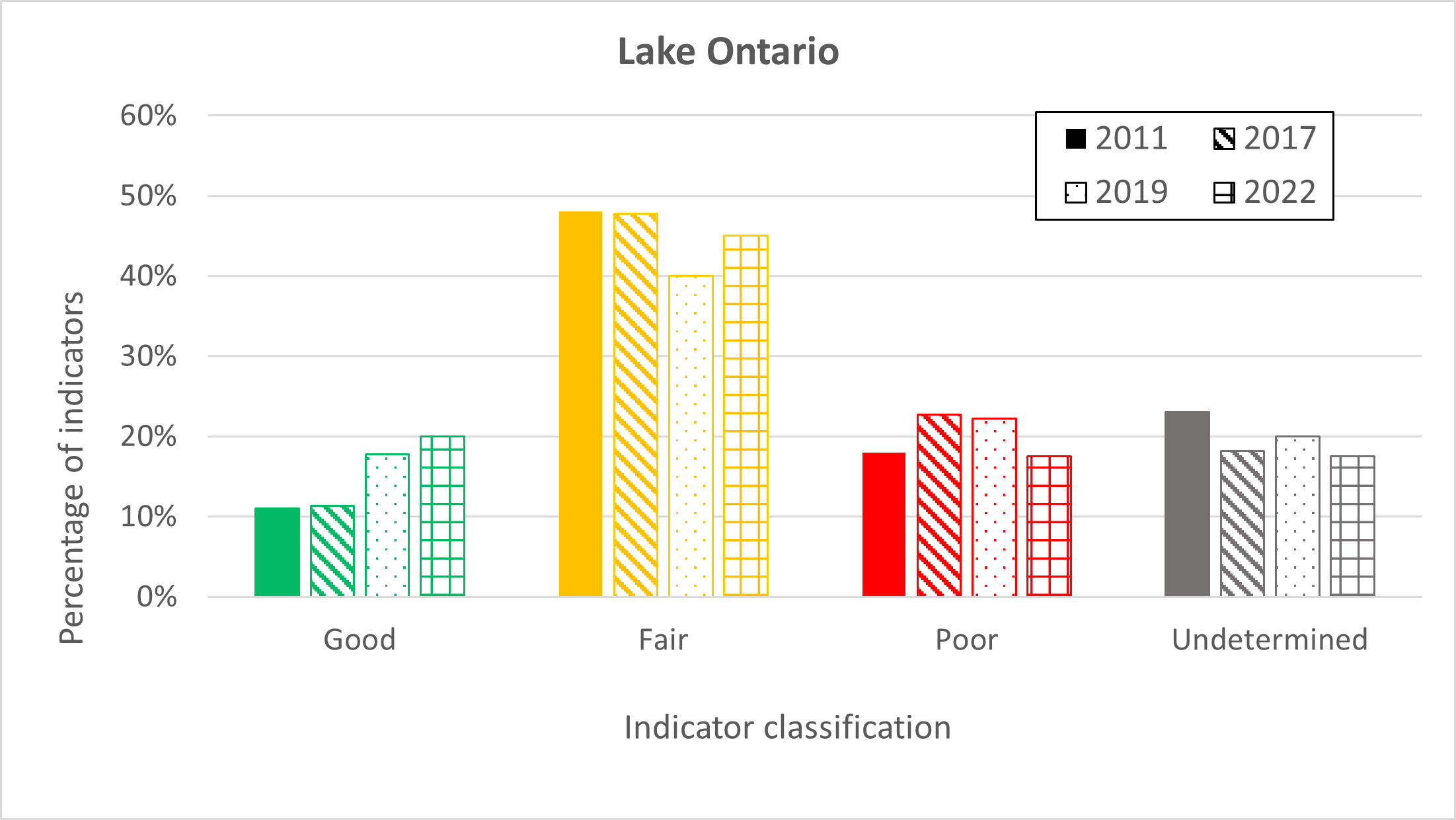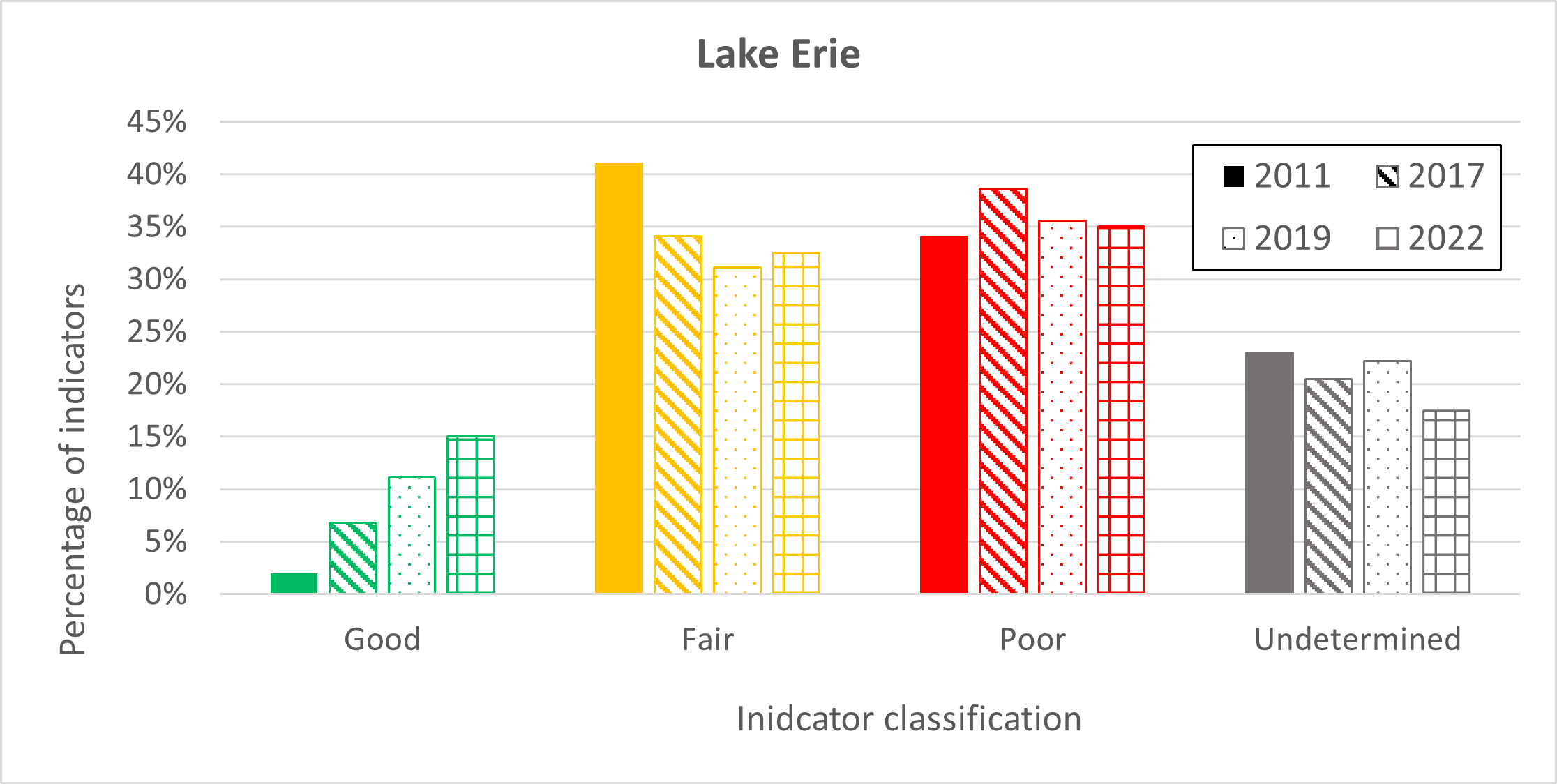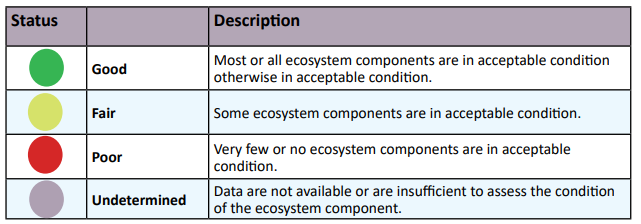Indicator
This indicator provides a lake-by-lake summary of the state of the Great Lakes based on information provided in the State of the Great Lakes 2022 report and examines changes from analyses done in 2011, 2017, 2019 and 2022.
Table 2. Assessment of the overall health of each of the Great Lakes in the 2017, 2019 and 2022 reports.
Figure 1. Percentage of the 40 sub-indicators that were classified as good, fair, poor, or undetermined in Lake Superior for 2011, 2017, 2019 and 2022 (ECCC and UEPA 2011, 2017, 2020, and 2022).
Figure 2. Percentage of the 40 sub-indicators that were classified as good, fair, poor, or undetermined in Lake Huron for 2011, 2017, 2019 and 2022 (ECCC and UEPA 2011, 2017, 2020, and 2022).
Figure 3. Percentage of the 40 sub-indicators that were classified as good, fair, poor or undetermined Lake Ontario for 2011, 2017, 2019 and 2022 (ECCC and UEPA 2011, 2017, 2020, and 2022).
Figure 4. Percentage of the 40 sub-indicators that were classified as good, fair, poor or undetermined Lake Erie for 2011, 2017, 2019 and 2022 (ECCC and UEPA 2011, 2017, 2020, and 2022).
Figure 5. Percentage of the 40 sub-indicators that were classified as good, fair, poor or undetermined Lake Michigan for 2011, 2017, 2019 and 2022 (ECCC and UEPA 2011, 2017, 2020, and 2022).
Status:
- Lake Superior is in generally good condition, with almost half of the indicators assessed as good (48%) and four indicators assessed as poor, (lake sturgeon, impacts of aquatic invasive species, rate of new aquatic non-indigenous species (ANS) established into each lake basin, and sea lamprey). This number is up from 2 indicators assessed as poor in 2019.
- The largest proportion of indicators for Lake Michigan (45%), Lake Huron (43%) and Lake Ontario (45%) were assessed as fair.
- The largest proportion of indicators for Lake Erie were assessed as poor (35%), which is close to those assessed as fair (33%). Six of Lake Erie’s indicators were assessed as good —zooplankton, walleye, treated drinking water, sea lamprey, groundwater quality, and toxic chemicals in herring gull eggs, up from 5 in the 2019 assessment.
Lake Superior
Lake Superior is assessed as good and unchanging, this can be in part due to its larger size, high percentage of natural land cover and relatively low development pressure. Lake Superior’s naturally lower water temperatures also promote resilience to nutrient and bacterial inputs. However, warming temperatures due to climate change may threaten this natural resiliency, particularly in shallow and enclosed bays.
The fisheries are healthy, the lower food web is strong and toxic chemicals are largely decreasing or remaining stable. There are self-sustaining populations of lake trout, supported by a stable and diverse prey fish population. Although lake sturgeon and other native fish have been affected by a lack of habitat connectivity, conditions are improving. Ongoing and emerging stressors include fluctuating water levels, invasive species, and continued contaminants in whole fish.
Water levels in Lake Superior have been below average since the 1990s, however in 2013 and 2014 levels rose very quickly and continue to be above long-term average values. In 2017 water levels were only a few cm below record high values and 2019 saw record high water levels again. The high rate of variability in climate conditions and the regional hydrologic cycles makes it difficult to determine whether these changes are expected to continue in the future. There is also concern that climate change will cause greater fluctuations in water levels. From an ecological perspective, short and long-term lake level fluctuations are critical to maintain healthy coastal habitats, especially wetlands.
Coastal wetlands in the basin are in fair condition, 62% of surveyed wetland sites have plant communities that are assessed as good, though there are numerous wetlands sites that are degraded. Dramatic or sustained long-term changes will continue to degrade these important habitats. The Lake is dependent on the health of the watersheds and tributaries that connect them. Concentrations of toxic chemicals (e.g. PCBs and PeBDEs) in lake trout and walleye continue to be above guidelines and remain stable. Total mercury concentrations, although still below the target, have returned to levels observed in the 1980s and appear to be stable in recent years.
Lake Huron
Lake Huron has been called “the lake in the middle”, both geographically and in terms of its environmental quality. In general, Lake Huron is assessed as good and unchanging. The Lake is a good source of high-quality drinking water and toxic chemicals monitored in the Lake show that long-term trends are declining. Chemical pollutants declined significantly during the 1970s and 1980s and levelled out more recently. PCBs and mercury level concentrations are lower than other lakes because it has fewer sources, and the lake is less subject to atmospheric deposition and retention due to its location.
Clear and clean water provide great swimming and recreational opportunities in the beaches and nearshore waters and the fish continue to be a good food source, with only certain species having consumption advisories.
Development, dams, non-point source pollution, invasive species and climate change are stressors on the ecosystem and are resulting in habitat degradation and loss. Lake Huron has suffered due to the invasion and spread of zebra mussel and quagga mussel and the disappearance of Diporeia, which impact on the Lake’s nutrient cycling and food web dynamics. Offshore prey fish populations have been declining since the mid-2000s and predator fish species, such as salmon have also decreased in number and total biomass. In contrast, nearshore species such as walleye and lake trout have not been impacted by the changes to the lower food web and are assessed as good and unchanging (walleye) and fair and improving (lake trout).
Harmful algal blooms linked to botulism are a problem in the southern portion of the lake. Massive fall die-offs of migrating loons and diving ducks due to botulism are reported annually in the lower Great Lakes including the southern portion of Lake Huron and Georgian bay.
Lake Huron’s coastal wetlands account for approximately 30% of the total wetland area for all five Great Lakes, and their conditions range from fair to good, with those in the northern regions generally in better condition, where agriculture and land use stressors are less common.
Lake Ontario
Although Lake Ontario is the smallest of the Great Lakes, its drainage basin is the most densely populated and provides ecosystem services to over 10 million people. The human population of the Lake Ontario basin has increased by more than 60% over the past 50 years. Still, Lake Ontario is showing improvements and is assessed as fair and unchanging to improving.
Past and current pressures on this ecosystem have led to drastic changes in nutrient dynamics, altered hydrology, loss of coastal habitats, and the introduction of invasive species, all with serious consequences to native species, food webs, and quality of life. Many of these changes have occurred rapidly and the Lake continues to respond in unpredictable ways.
Progress has been made to reduce stressors including decreasing the amount of nutrients and toxic chemicals entering the lake and restoration of degraded habitats. These improvements have led to the return of osprey and bald eagle to the shores of Lake Ontario and have supported initiatives to restore native lake trout and Atlantic salmon to the region, and native deepwater sculpin, a species once thought extirpated, are recovering naturally, while stocking efforts to restore other native prey fish are proving successful. Lake sturgeon populations are also showing some signs of recovery with spawning occurring in a few tributaries.
Over the past 10 years, there have been fewer beach closures and the contaminant concentrations in fish have declined, however there does remain consumption advisories in effect for certain fish species. Even still, a number of fish, bird and wildlife populations have declined in Lake Ontario, due in part, to destruction of habitat, overfishing, the introduction and spread of invasive species and toxic contaminants. In particular, the invasion of zebra mussel and quagga mussel and the disappearance of Diporeia continue to impact the Lake’s nutrient cycling and food web dynamics. Parts of Lake Ontario have seen a resurgence of harmful algal blooms since 2008 which are caused by a combination of elevated nutrient levels, invasive species, warmer temperatures, and higher frequency of precipitation.
Lake Erie
Lake Erie is assessed as poor and unchanging. Despite early successes in reducing phosphorus loads to the Lakes after the 1972 GLWQA was implemented, Lake Erie continues to be threatened by excessive nutrient inputs from non-point sources such as urban and rural run-off. Nutrients and algae continue to be a significant issue, and Cladophora growth continues to be a problem in the eastern basin. Harmful algal blooms have become a regular occurrence in the western basin during the summer months. These blooms impact drinking water treatment systems and recreational activities. Compounding this problem, in-lake nutrient cycling has changed due to the spread of invasive zebra mussel and quagga mussel that became established in the 1980s. This alteration of nutrient flow is contributing to greater nuisance algal growth in the near shore regions, while deeper offshore waters are deprived of oxygen causing “dead zones” for aquatic life.
Other changes contributing to the resurgence of algae include the significant loss of wetlands and riparian vegetation that once trapped nutrients. The loss of millions of ash trees across Ontario increased amounts of stormwater runoff and has led to more pollutants and sediments going into the waters. Shifting communities of phytoplankton, increased water clarity and climate issues such as warmer waters and extreme precipitation events also play a role. As a result of these ecological changes, the fish community in Lake Erie has also suffered. Some fish have been extirpated (e.g., blue pike, shortnose cisco). Progress has been made to improve aquatic connectivity and quality of spawning habitats helping to increase walleye across the lake as well as lake sturgeon in the St. Clair-Detroit river system.
Lake Erie supports the largest self-sustaining walleye population in the world. Lake trout populations have increased due to the decline in sea lamprey, and though lake trout populations have been entirely supported by stocking for decades, wild lake trout hatchlings were captured in the New York waters in 2021 providing evidence of natural reproduction for the first time in 60 years. Diporeia, an important cold-water species, is likely extirpated from the eastern basin where it has not been seen since 1998.
Lake Michigan
Lake Michigan is located entirely within the United States; however, these waters are part of a larger shared system, and the state of the Lake has impacts on the entire Great Lakes Basin, including the Province of Ontario. In general, Lake Michigan is assessed as fair and unchanging with both positive and negative trends.
The removal of dams, restoration of wetland habitat and riverine spawning habitat, and continued decline of contaminants such as PCBs in fish have resulted in improvements. Aquatic habitat connectivity is still considered poor with over 80% of tributary habitat no longer accessible to migratory fish, though projects implemented over the past decade to remove barriers have increased connectivity. PCB levels from fish in Lake Michigan have historically been the worst among the Great Lakes, but substantial declines show levels are nearing the other Great Lakes.
The aquatic food web is under stress because Diporeia, a small crustacean that is an important food for many fish species, has almost disappeared. Despite the declines in Diporeia, high total benthic biomass (including Dreissena) can likely support abundant benthivorous fish populations. Several invasive species such as Round Goby, Zebra Mussel and Quagga Mussel continue to cause significant changes in water clarity and fertility, resulting in major changes to Lake Michigan’s ecosystem. Both Zebra and Quagga mussels have contributed significantly to the decline of Diporeia. Invasive species continue to expand their range causing environmental impacts, including widespread algal growth which is suspected of playing a role in Type E Botulism outbreaks that have caused the death of large numbers of fish-eating birds. Viral Hemorrhagic Septicemia (VHS) has also become established and has caused significant fish die-offs. Despite challenges from invasive species and long-term decline of zooplankton there is an increase in natural reproduction of Lake Trout, due in part to the successful control of invasive Sea Lamprey.
Last Updated: November 13, 2024

